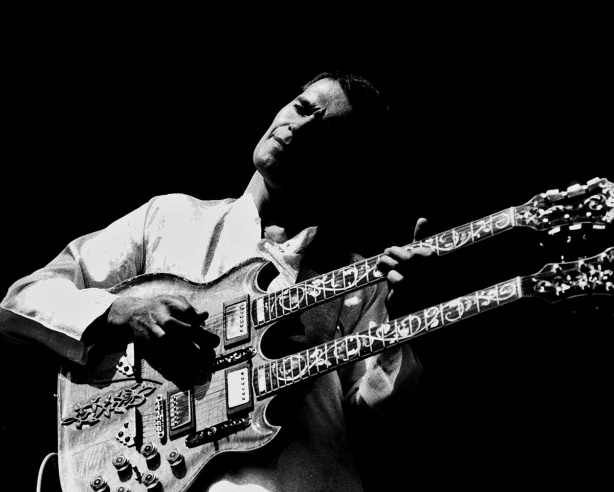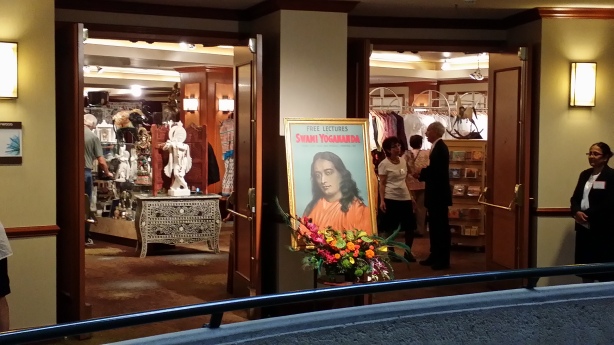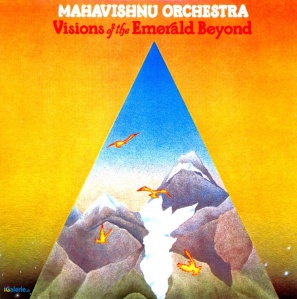by Fred W. Anson
At what point does recontextualized music drift into syncretism and/or compromise?
Once a year the Los Angeles Bonaventure hotel that I pass through on my way into work gets overrun by the Self Realization Fellowship (SRF). For those unfamiliar with the SRF here’s a quick synopsis:
Self-Realization Fellowship (SRF) is a worldwide spiritual organization founded by Paramahansa Yogananda in 1920 and legally incorporated as a non-profit religious organization in 1935, to serve as Yogananda’s instrument for the preservation and worldwide dissemination of his writings and teachings, including Kriya Yoga. Yogananda wrote in God Talks With Arjuna: The Bhagavad Gita that the science of Kriya Yoga was given to Manu, the original Adam, and through him to Janaka and other royal sages.
Self-Realization Fellowship continues to disseminate Paramahansa Yogananda’s teachings following his stated Aims and Ideals. SRF publishes Yogananda teachings of home-study lessons, writings including Autobiography of a Yogi, lectures, and recorded talks; oversees temples, retreats, meditation centers, and monastic communities bearing the name Self-Realization Order. It also coordinates the Worldwide Prayer Circle, which it describes as a network of groups and individuals who pray for those in need of physical, mental, or spiritual aid, and who also pray for world peace and harmony.
SRF is based at Mount Washington in Los Angeles, California, which is the international headquarters for SRF and for Yogoda Satsanga Society of India (YSS). YSS was founded by Yogananda in 1917 before he came to America. In countries outside the Indian subcontinent the organization is known as Self-Realization Fellowship.1
That’s the long version, the short version is this: It’s Hinduism. Or, more precisely, according to Elliot Miller of Christian Research Institute (CRI) it’s, “a kind of New Age Hinduism in Christian garb.”2 So once a year for about a week, I wander through this strange hindu-land on my way to pick up my lunch on my way to my job in the building next door. And as I do, when I’m not quieting praying, this is what I sing:
Let me fulfill thy will
Let me fulfill thy will
Oh Lord Supreme, Supreme
Let me fulfill thy will
Let me fulfill thy will
Oh Lord Supreme, Supreme
Let me fulfill thy will
Let me fulfill thy will
Oh Lord Supreme, Supreme
Let me fulfill thy will
Let me fulfill thy will
Let me fulfill thy will
Come by my side
Let me fulfill thy will
Come by my side
Let me fulfill thy will
Come by my side
Let me fulfill thy will
Come by my side
Let me fulfill thy will
Come by my side
Oh Lord Supreme, Supreme
Let me fulfill thy will
Let me fulfill thy will
Oh Lord Supreme, Supreme
Let me fulfill thy will
Let me fulfill thy will
Oh Lord Supreme, Supreme
Let me fulfill thy will
Let me fulfill thy will
Of course anyone who was a Jazz Fusion aficionado in the seventies will tell you that I’m singing, “Eternity’s Breath, Part 1” by the Mahavishnu Orchestra3 from the 1975 album “Visions of the Emerald Beyond”. Of course I’m not singing it to Vishnu as the original artists were, I’m singing it to the only true God – the God of Israel, Yahweh Elohim. I’m singing it to the only true Lord, my Lord, Jesus Christ.
However, this song was written to neither. The composer and founder of the Mahavishnu Orchestra, John McLaughlin, was a disciple of Sri Chinmoy and a Hindu.4 As McLaughlin explained in a 1982 interview:
By the time I was 27, I’d already started doing Hatha Yoga and doing mind and breathing exercises. I felt more capable mentally, but I had this feeling I was being tuned up but not being played very well, which relates to what we were talking about a while ago. I felt the need to learn from somebody who really knows.
I arrived one evening at a meditation featuring Sri Chinmoy and he invited questions. I thought, “Great, this is the first time anyone has ever invited questions,” so I said, “What’s the relationship between music and spirituality?” and he said, “Well, it’s not really a question of what you do. It’s what you are or how you are that’s important because you can be making the most beautiful music sweeping the road, if you’re doing it in a harmonious way, in a beautiful way.” It sounds so simple, of course, but it was everything I wanted to hear and I felt I should stay with him, which I did for five years.5

John McLaughlin working his craft with the Mahavishnu Orchestra around the time that Eternity’s Breath was recorded.
All that aside, what I do know is that I love this song! McLaughlin’s incendiary but elegant guitar, Jean Luc Ponty’s soaring violin, Narada Michael Walden’s driving drums, Ralphe Armstrong’s melodic bass, Gayle Moran’s inspired keyboard work, all combined with gorgeous, tightly harmonized vocals. It’s a classic.
And I know that when I sing it I’m worshiping my God not the god of Sri Chinmoy or John McLaughlin. Further, I would go so far as to say that if there’s such thing as a Christian mantra this contextualized song is mine – it captures my deepest heartfelt desire for living my life Coram Deo (Latin for “Before the eyes of God” or “In the presence of God”), as the words so simply yet profoundly say:
Oh Lord Supreme, Supreme
Let me fulfill thy will
Let me fulfill thy will
Is that syncretism? Is it compromise? Or is it, Jesus Christ redeeming this song and taking it captive to His purposes; conquering it for His Kingdom, and; putting it under His foot? I think it is – but you tell me, for I’m only an fallen man, and prone to be deceived. Which is why I sing:
Oh Lord Supreme, Supreme
Let me fulfill thy will
Let me fulfill thy will
NOTES
1 “Self-Realization Fellowship”, Wikipedia
2 Elliot Miller, “Swami Yogananda and the Self-Realization Fellowship”
3 According to Wikipedia, “Mahavishnu” means, “Mahavishnu (Devanāgarī : महाविष्णु) is an aspect of Vishnu, the Absolute which is beyond human comprehension and is beyond all attributes.”
4 As were guitarist Carlos Santana, percussionist Narada Michael Walden, singer Roberta Flack, saxophonist Clarence Clemons and Russian rock legend Boris Grebenshikov. Wikipedia explains:
“Chinmoy offered the musicians a disciplined spiritual path that forbade the use of drugs and alcohol and encouraged music and poetry as expressions of thankfulness to the Divine.
“[Carlos] Santana and [John] McLaughlin stayed with Chinmoy for a number of years before leaving. In 1973 they released an album based on Chinmoy’s teachings, titled Love Devotion Surrender. McLaughlin was a Chinmoy follower from 1970 to 1975. In 1971 he formed the Mahavishnu Orchestra, named for the spiritual name Chinmoy had given him. Santana was introduced to the guru when McLaughlin took him to one of Chinmoy’s weekly prayer meetings at the United Nations. Santana and his wife Deborah were Chinmoy followers from 1972 to 1981, and Santana said, “Without a guru I serve only my own vanity, but with him I can be of service to you and everybody. I am the strings, but he is the musician. Guru has graduated from the Harvards of consciousness and sits at the feet of God.” Santana released three albums under the spiritual name Devadip – meaning “Lamp of God”, “Eve of God”, and “Light of God” – that Chinmoy gave him: Illuminations (1974), Oneness (1979), and The Swing of Delight (1980). In 2000, he told Rolling Stone that things soured between him and Chinmoy in the 1980s. Santana emphasized that he took much that was good from his years with the guru, even though when he left, Chinmoy “was pretty vindictive for a while. He told all my friends not to call me ever again, because I was to drown in the dark sea of ignorance for leaving him.”‘
(“Sri Chinmoy”, Wikipedia)
5 Robert Fripp, “Coffee and Chocolates for Two Guitars”, Musician magazine, number 45, July, 1982



How is it that the devotion of a person of one faith can inspire a person of a different faith and resonate with them deeply? Maybe it’s worth asking how this type of interfaith experience is possible.
One simple explanation is that when you go to the zenith or pinnacle of Christianity, Judaism, Hinduism and other religions, there you encounter the selfsame God — called the Supreme or Absolute in Hindu philosophy.
The lyric
Oh Lord Supreme, Supreme
Let me fulfill thy will
Let me fulfill thy will
is not being sung to Vishnu, but to God — to the “Lord Supreme.” God is omnipotent and omnipresent, so do you not think He knows when He is being addressed and worshipped? You also recognize it intuitively when you hear God being worshipped, because you are blessed with a devotional temperament. So you get tremendous inspiration from that Mahavishnu Orchestra song.
Music takes us beyond words and beyond mental distinctions. Music has the power to bring us spiritual insights which our mind may not understand. God can teach us through music, so it’s good to accept the lessons that come through music and gradually adjust our thinking to reflect these higher truths.
Some Christians take an interfaith approach rather than an apologetics approach. See “Jesus is born — in a world of many faiths,” a sermon by Revd Canon Barbara Moss which also quotes from Sri Chinmoy’s book Brother Jesus:
Michael
LikeLike
From Christian author Janis Hutchinson in response to this article:
‘Confucius, who preceded Christ by 5 centuries, taught the Golden Rule: “Do not impose on others what you do not wish for yourself.” This was one of the guiding principles of life that Confucius taught his followers. Since Jesus said the same thing centuries later in the Sermon on the Mount, does that mean Jesus believed in confucianism? Of course not. Therefore, if you want to sing words that mean something different in a different religion, but you’ve changed it to mean something different for you as a Christian, nothing wrong with it!
As long as quoting the song doesn’t draw your mind to what they believe. Some ex-Mormons, for ex, could retain good verses from the Book of Mormon, but it often keeps them linked to what the Bk of M. stands for, and the whole Mormon package. So, this principle wouldn’t work for some.’
(posted in the Evangelicals Discussing Mormonism Facebook group on August 21, 2016)
LikeLike